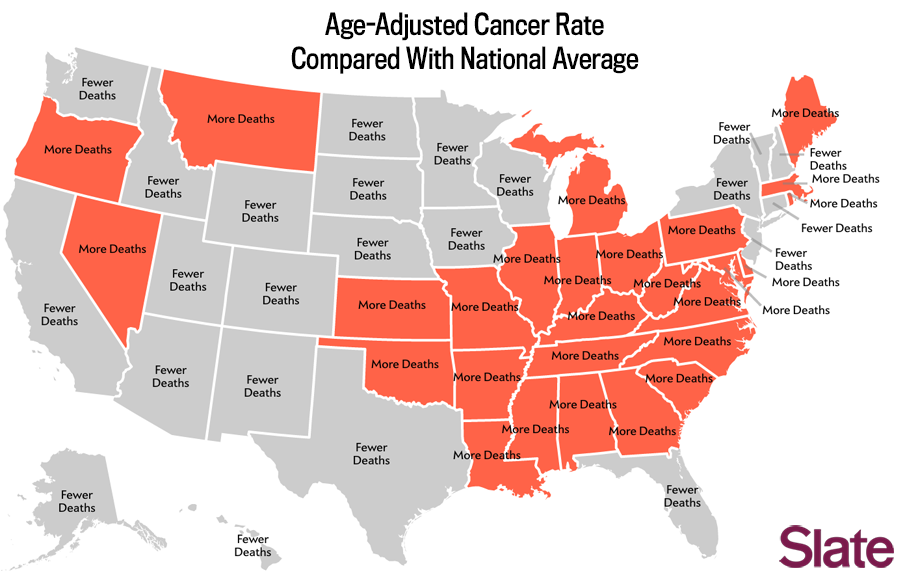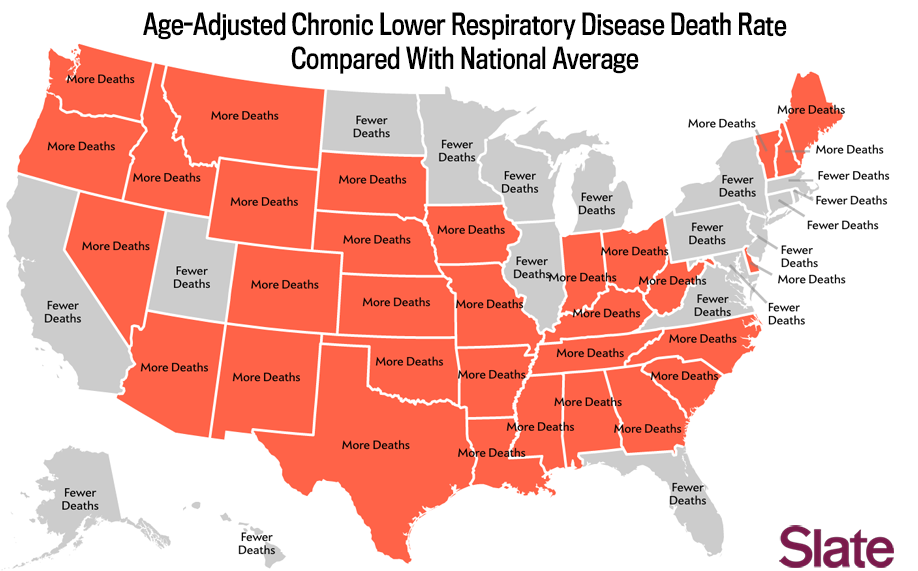You Live in Alabama. Here’s How You’re Going to Die.
A look at the most common causes of death by state.
By Ben Blatt
Two months ago, I wrote about the fun and the pitfalls of viral maps, a feature that included 88 simple maps of my own creation. Since then I’ve written up a bunch of short items on some of those maps, walking through how they can both illustrate great information and hide important details. At one point, I said I was done with these. Well, I wasn’t. Here’s another, on death. Enjoy!
The data used to create the table below are from a 2008 CDC report that’s based on numbers from 2005. Ideally, we’d have more up-to-date information, but their page on mortality tables indicates that there’s nothing more recent on state-by-state causes of death.

Data source: Centers for Disease Control and Prevention. Map by Ben Blatt/Slate.
The map above, included in the original interactive, showed the most common causes of death excluding heart disease and cancer. The reason for the exclusions was to create more geographic variation. Heart disease and cancer, the top two leading causes of deaths in every state, account for more deaths than the next eight causes of death combined

Data source: Centers for Disease Control and Prevention. Map by Ben Blatt/Slate.
In these first two maps, we still only see five causes of death: heart disease, cancer, stroke, accidents, and respiratory diseases. Inspired by an , I created a map in the original interactive that showed which cause (in the national top 10) affected each state at a rate most disproportionate to what one would expect based on the national rates. (I measured this using a ratio of state level rate to national rate, also known as the location quotient.)
The 10 causes as classified by the CDC are “diseases of heart” (heart disease), “malignant neoplasms” (cancer), “chronic lower respiratory diseases” (respiratory diseases), “cerebrovascular diseases” (stroke), “accidents,” “Alzheimer’s disease,” “diabetes mellitus” (diabetes), “influenza and pneumonia,” “nephritis, nephrotic syndrome, and nephrosis” (kidney diseases), and “septicemia.”

Data source: Centers for Disease Control and Prevention. Map by Ben Blatt/Slate.
I included this map because it illustrates a few things the other two don’t, mainly the regionalism in diseases like septicemia and kidney diseases. But this map—like many maps which purport to show attributes meant to be “distinct” or “disproportionate”—can be misleading if not read properly. For one thing, you cannot make comparisons between states. Looking at this map, you probably would not guess that Utah has the sixth-highest diabetes rate in the country. Diabetes just happens to be the one disease that affects Utah most disproportionately. Louisiana has a higher diabetes death rate than any state, but is affected even more disproportionately by kidney disease.
If you’re interested in geographic variation of cause of death, I’d recommended looking through the data (either on the CDC site or easily organized on this site). But I also realize data tables are not as fun as maps, so below is an attempt to break down the numbers in a more granular but still visual manner. For instance, take this map that shows which states have more people die from accidents than the national average.

Data source: Centers for Disease Control and Prevention. Map by Ben Blatt/Slate.
It should be noted that each state’s rate is compared with the national average, not the median. That’s why it’s possible for 30 states to have more deaths than the national average.

Data source: Centers for Disease Control and Prevention. Map by Ben Blatt/Slate.
It should also be clear that this data is not normalized by state. This means a cause of death may be uncommon for its own state, but still higher than the national average. For instance, a person from Alabama dies from every single one of the nation’s top 10 causes of death at an age-adjusted rate that exceeds the national average.
By contrast, the age-adjusted death rates for the top 10 causes of death are all lower in Minnesota than they are nationally. It makes sense, then, that the most recent estimatesby the CDC have the life expectancy in Minnesota as nearly five years longer than in Alabama.
Below are maps for the other top eight causes of death. Accidents are the fourth-leading cause and heart disease is the first. The rest are presented in sequential order.

Data source: Centers for Disease Control and Prevention. Map by Ben Blatt/Slate.

Data source: Centers for Disease Control and Prevention. Map by Ben Blatt/Slate.

Data source: Centers for Disease Control and Prevention. Map by Ben Blatt/Slate.

Data source: Centers for Disease Control and Prevention. Map by Ben Blatt/Slate.

Data source: Centers for Disease Control and Prevention. Map by Ben Blatt/Slate.

Data source: Centers for Disease Control and Prevention. Map by Ben Blatt/Slate.

Data source: Centers for Disease Control and Prevention. Map by Ben Blatt/Slate.

Data source: Centers for Disease Control and Prevention. Map by Ben Blatt/Slate.
http://slate-static-prod.s3.amazonaws.com/etc/designs/slate/images/narrow-black-line.4b966049.gif?1399407032); background-attachment: initial; background-origin: initial; background-clip: initial; background-color: initial; background-position: 0% 0%; background-repeat: no-repeat no-repeat; ">
Ben Blatt is a Slate staff writer and co-author of I Don't Care if We Never Get Back. Email him at
This e-mail address is being protected from spambots. You need JavaScript enabled to view it
or follow him on Twitter.
|